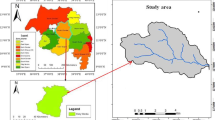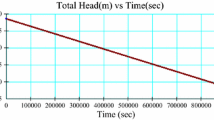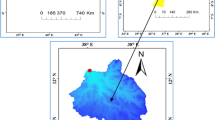Abstract
This research work was carried out using Geo-Slope software programmes, i.e., to compute the infiltration and slope stability analysis of the Grindeho dam using SEEP/W and SLOPE/W. Embankment dam failure may occur due to different reasons, such as structural instability, hydraulic conditions, seepage through the dam body and foundation. The determination of the factor of safety for the dam slope stability and quantify the amount of seepage through the dam, under different cases of operations, is vital to ascertain the dam overall safety. In this research, Finite Element modelling is used through Geo-Studio software to simulate slope stability and seepage analysis of the embankment dam. Three distinct operational cases are considered for the dam analysis: end of construction before filling the reservoir, after/full reservoir condition, and rapid reservoir condition drawdown. Four separate methods of analysis were used to verify the stability of the slope embankment: Morgenstern-Price, Bishop, Janbu, and Spencer. The requirements of the Benchmark Safety Legislation (US Army of Corps Engineers and British Dam Society) are observed. The simulation results of the upstream and downstream side of the dam section have a direct effect on the factor of safety, the outcome of the stability analysis performed showed that all sections of the dam are safe within the specified range of factors of safety for the potential all loading and operation cases. But all the slip surfaces move through the section of the dam shell, which shows that this zone is the weaker zone and requires spatial attention. The simulation results obtained from the SEEP/W program revealed that 15,291.5 m3/year and 22,818.56 m3/year amount of seepage loss is present in the Grindeho dam during the drawdown case and full reservoir case, respectively.
Similar content being viewed by others
Avoid common mistakes on your manuscript.
Introduction
Initially, for water supply and irrigation, only small dams were built. Today, however, many countries in the world have high priorities for dam building for various purposes (irrigation, hydropower, navigation, fisheries, etc.). About 1 billion people depend on food produced by reservoir related irrigation (FAO 2017). There is no alternative to how this food could have been produced by other means. Many countries in the world are impacted by water shortage. Thousands of dams have yet to be constructed to store water and make it available worldwide during the first half of this century  especially in developing countries.
especially in developing countries.
As 80% and above of the people in the country rely on agriculture, Ethiopia also gives high priority to the construction of the embankment dam. (FAO 2017). And most of the agricultural practices depend on natural rainfall, and the actual avoidance of the country’s famine and drought is the beginning of numerous water supply projects, i.e., if no rain, the continuity life in the country will enter under notation (Bewket 2008). Various water resource projects, such as dams and irrigation projects, which support the supply of water from natural rainfall and ensure the sustainability of life, should therefore be built in different areas (feasible areas) of the country to avoid this risk. Among them, the Grindeho dam is built to help the struggle against drought, but due to the presence of a high amount of seepage on the d/s face of the dam, the life of this dam is at risk. In addition to the objective of economic benefits, most of the dam projects often discuss the overall socio-economic growth of the people in the region (Head n.d.). One of the key benefits of irrigation schemes is to discourage rural people from commuting to the cities, while at the same time providing them with a higher standard of life in their native areas. Seepage under an embankment is much more dangerous than that for a concrete dam (Htwe and Naing 2017), since embankments are usually built on soft material which is liable to be scoured out. Whereas a concrete dam is usually built on rock which is not worn away so rapidly by the scouring action of water, and even then a defective dam will not necessarily be endangered by passage of water through it or even under it (Johansson 1997).
Overtopping and internal erosion through the dam or the foundation is the most frequent reason for embankment dam failures (Schmertmann 2004).
Recent research shows that embankment dam failure caused by internal erosion can occur very suddenly, and it may be just a few hours from an early warning of a concentrated leak at the downstream toe to a complete dam failure at the crest (Schmertmann 2004).
It is vital for the growing future safety of the dam to minimise the amount of water seeping through the dam body and foundation to determine good building quality in dams, particularly embankment dams. But, this is difficult to detect by conventional methods. So, it needs to develop a new method. Geo-studio computer program is one of basic methods to accomplish this task.
The analysis is conducted using the state-of-the-art finite element method-based computer program—Seep/W from Geo-studio international, Unsaturated and saturated flow within the slopes was modelled with a finite element seepage analysis using SEEP/W (Geo-studio 2012) software.
Study area
General description of study area
The Grindeho dam is located in the eastern zone of Tigray regional state. The existing rain-fed agricultural practice in the area has been seriously affected by recurrent drought. To alleviate this problem, the solution sought is to support and shift the existing rain-fed agricultural practice to modern irrigation with sustainable use of both surface and groundwater resources.
The Grindeho dam site is found in the Tekeze basin having a good potential of surface water that can irrigate more than 100 ha during the dry season.
Also, as a consequence of this project, water for livestock and other developmental packages will not be a problem after the implementation. In other words, apart from the irrigation practice, other development opportunities, such as road, job, ecological changes, and fish, will be some of the benefits from the project.
Input data
The necessary input data (i.e., Dam design cross-sectional, geological report data, reservoir Water level from the dam site recorded data, detail dam design report and laboratory test result, material properties of dam) required for the Geo-studio computer program are collected from Tigray Water Works Design and Supervision Enterprise (TWWDSE) and Water Works Construction Enterprise as well as from Grindeho dam site.
Location of the project area
Grindeho dam site, reservoir and its command area are located in the Northern part of Ethiopia, Tigray region. The geographic location of the dam site is 571,209 mE and 1,508,393 mN (UTM zone-37).
Specifically, it is located in the eastern zone of Tigray Regional State, Woreda—KeletAwlaelo and Tabia Hadent. The site is located 44 km northeast of Mekelle and it has the total catchment area of 78.03 km2.
The location of the Tigray Regional Government, KeletAwlaelo woreda and the project area are shown in the figure below.
Grindeho dam site is located on the southeastern side of Agulae village/town at about 27 km (Fig. 1).
Input data
The necessary input data (i.e., Dam design cross-sectional, geological report data, reservoir Water level from the dam site recorded data, detail dam design report and laboratory test result, material properties of dam) required for the Geo-studio computer program are collected from Tigray Water Works Design and Supervision Enterprise (TWWDSE) and Water Works Construction Enterprise as well as from Grindeho dam site.
Geotechnical parameters for analysis and design
To determine the engineering properties of the fill materials, representative soil samples were collected from the proposed dam site and laboratory test has been done in the Tigray Water Resources Bureau-Geotechnics and Laboratory center (Tables 1, 2).
Methods of analysis
Quality assessment of dam activities using geo-studio software has not been a standard technique in the past, but it will be one of the best alternative methods for assessing dam protection in the future. Seep/W from Geo-studio International, Unsaturated and saturated flow inside the slopes was modelled with a finite element seepage analysis using SEEP/W (Geo-studio 2012) software. The analysis is performed using the state-of-the-art Finite Element method-based computer program (Fig. 2).
Field and lab tests
Lab result output
Proctor test
Proctor test (optimum moisture content and maximum dry density determination) is decided graphically as shown below on the graph which is drawn dry density versus moisture contents (Fig. 3).
From the above graph, M.D.D is 1.4704 g/cm3 and O.M.C is 29.6%. Finally, this result is sent to field for compaction test.
Atterberg limit test (LL, PL and PI)
The result of moisture content versus number of blows, the resulting graph is shown below (Fig. 4).
Finally, we can read the liquid limit from the resulted graph and plastic limit by taking the average of the two trial values. The plasticity index is then, the difference of liquid limit and plasticity index.
Field test
Compaction test for clay
For field compaction studies, we use input data from laboratory findings that we saw earlier in the proctor test. These data are O.M.C and M.D.D which have a calculated result of 29.6% and 1.4704 g/cm3, respectively.
Seepage and slope stability
Seep/w is the software used in this study for simulating the water seepage from a reservoir through an earth dam, and slope/w is the software utilized for computing the factor of safety against slope failure using different methods and under different soil conditions (Mishal and Khayyun 2018). The general governing differential equation for two-dimensional seepage is expressed as:
where H is the total head; kx and ky are the hydraulic conductivity in the x and y directions, respectively; Q is the flow rate and ⊖ is the volume water content. This equation expresses that the difference between the input and output flow rates is equivalent to the change in storage of the soil systems. SLOPE/W solves two factors of safety equations (force and momentum). All the used methods of slices can be visualized as special cases of the General Limit Equilibrium solution. A factor of safety is characterized as that variable by which the soil shear strength must be reduced so that the mass of soil will bring into a condition of constraining balance along a chose slip surface (Mishal and Khayyun 2018).
The shear strength for an effective stress analysis is defined as:
where S is the shear strength; C′ is the cohesion of the soil; ∅′ is the angle of friction; σnis tℎe total normal stress and u is the pore-water pressure. The slip surface may be circular, linear or comprises any shape characterized by a progression of straight lines. The factor of safety in horizontal force equilibrium is:
And the factor of safety in moment of equilibrium is:
where W is the slice weight; N is the normal force on the base of the slice; D is an external load; kW is the horizontal seismic load; R is the radius for a circular slip surface; x and e are the horizontal and vertical distances from the centerline of each slice to the center of rotation, respectively; d is the vertical distance from a point load to the center of rotation; a is the vertical distance from the resultant external water force to the center of rotation; A is the resultant external water forces and ω, α, β are the angle of the load from the horizontal, the angle between the tangent to the center of the base of each slice, and the horizontal.
Stability analysis using the limit equilibrium methods (LEM)
Limit equilibrium methods assume that when a slope fails, a rigid soil mass is sliding on a potential failure surface (Liu and Zhao 2013). At failure, soil strength is fully mobilized along the failure surface and the sliding mass is in static equilibrium. Slope stability is usually expressed in terms of a factor of safety that is usually defined as:
Thus, the factor of safety is a ratio of the shear strength capacity of the soil to the shear stress induced on the potential failure surface (US Army Corps 2003).
Embankment dam failures
A review of the data from the 1975 and 1988 (Safety 2012), studies indicate that about 40 percent of failures and accidents to embankment dams are the result of leakage and piping through the dam, foundation, and/or the abutments.
Output results of Geo-Studio software
Seepage in the dam
As the result shown below, 4.5294e−0.06 m3/s water seepage is through the core of the dam to the downstream (Fig. 5).
Seepage losses
The annual amount of water loss through the dam body and foundation is:
where q = seepage loss rate (m3/year/m) and B = total width of dam, (width of seepage path, B = 159.75 m), q = 4.5294 × 10−6m3/s/m or 142.84 m3/year/m.
For 50-year design period, 1140928 m3 water loss is by seepage though embankment and foundation (Fig. 6).
Seepage losses
The annual amount of water loss through the dam body and foundation is determined by (Q = q × B) formula,
where q = seepage loss rate (m3/year/m) and B = total width of dam, (width of seepage path, B = 159.75 m), q = 3.0353 × 10−6m3/s/m or 95.72 m3/year/m.
For 50-year design period, 764573 m3 water loss is by seepage though embankment and foundation.
Slope stability analysis of dam
For slope analysis of the dam, three different cases of operation are considered: end of construction before filling the reservoir, after/full reservoir condition and rapid drawdown of the reservoir. Four major analytical methods are used to assess the stability of the dam: Morgenstern-Price, Bishop, Janbu, and Spencer. Benchmarks for the safety regulation criteria are United States army of Corps Engineers and British dam society.
Reservoir full condition
A. Downsteam of the dam for full reservoir case
The factor of safety determination of the dam under different methods of analysis is listed below (Figs. 7, 8, 9, 10).
B. Upstream of the dam for full reservoir case (Figs. 11, 12, 13, 14).
Reservoir empty condition
A. Downsteam of the dam for empty reservoir case (Figs. 15, 16, 17, 18).
B. Upsteam of the dam for empty reservoir case (Figs. 19, 20, 21, 22).
Drawdown of the reservoir condition
A. Upsteam of the dam for Drawdown reservoir case (Figs. 23, 24, 25, 26).
Summary of the result in Table 3.
Conclusion
The purpose of this paper is to calculate the amount of seepage through the dam and assess the slope stability of the embankment dam using the state-of-the-art machine program-based Finite Element Method through Geo-studio (2012) software.
The outcome of the stability analysis carried out showed that for all potential loading and operation scenarios, all parts of the dam are safe within the specified set of safety factors. But all the critical slip surfaces pass through the dam shell section, which means that this region represents the weaker region based on stability. The grindeho dam project is planned to harvest 4,283,238.9 m3 of water from a catchment area of about 78.03 km2 to introduce a modern irrigation practice downstream side of the dam.
The result of seep/w analysis showed 15,291.5 m3/year seepage loss during a reservoir drawdown case and 22,818.56 m3/year seepage loss though the dam during full reservoir case. This means during drawdown and full reservoir case, the seepage loss in 50-year design period is 1,140,928 m3 and 764,573 m3, respectively.
References
A report produced for the G20 Presidency of Germany (2017). Water for Sustainable Food and Agriculture Water for Sustainable Food and Agriculture
Bewket W (2008) Rainfall variability and agricultural vulnerability in the Amhara Region, Ethiopia. Ethiopian J Develop Res 29(1):823–836
Head, Deputy (2020) Cuma CAKMAK, Deputy Head, State Hydraulic Works (DSI), The Role of Dams in Development. Pp. 59–63
Htwe, Hla M, Tun N (2017) Seepage and slope stability analysis of myittha multipurpose dam project, Gangaw Township, Magway Region, Myanmar. In: IPTEK Journal of Proceedings Series 3(6)
Levee S (2012) Dam and Levee safety and community resilience: a vision for future practice dam and levee safety and community resilience: a vision for future practice
Liu F, Zhao J (2013) Limit analysis of slope stability by rigid inite- element method and linear programming considering rotational failure. Int J Geomech 13(6):827–839
Mishal, Usama R, Thair K (2018) stability analysis of an earth dam using GEO-SLOPE model under different soil conditions. Eng Technol J 36(5A)
Sam J (1997) Doctoral dissertation, Department of Civil and Seepage Monitoring in Embankment Dams. https://kth.diva-portal.org/smash/get/diva2:8066/FULLTEXT01
Schmertmann JH (2004) Discussion of ‘time for development of internal erosion and piping in embankment dams.’ J Geotech Geoenviron Eng 130(9):980–980
US Army Corps (2003) Engineering and design, slope stability, engineer manual. US Army Corps of Engineers 49(3):EM 1110-2-1902
Yousuf M (2018) A comparison between limit equilibrium and finite element methods for slope stability analysis. 0–17

Author information
Authors and Affiliations
Corresponding author
Additional information
Publisher's Note
Springer Nature remains neutral with regard to jurisdictional claims in published maps and institutional affiliations.
Rights and permissions
About this article
Cite this article
Hailu, M.B. Modeling assessment of seepage and slope stability of dam under static and dynamic conditions of Grindeho Dam in Ethiopia. Model. Earth Syst. Environ. 7, 2231–2239 (2021). https://doi.org/10.1007/s40808-020-01006-2
Received:
Accepted:
Published:
Issue Date:
DOI: https://doi.org/10.1007/s40808-020-01006-2































